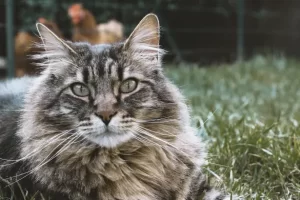Last updated on March 4th, 2023 at 11:02 pm

Discovering that your cat has worms can be worrying and upsetting for most pet owners. It is very common for cats to have worms. The most common type of worms are roundworms, tapeworms, and hookworms. A cat can get worms from eating a rodent that has worms, drinking water contaminated with worm eggs, or from its mother while nursing. Roundworms can be contracted by ingesting eggs that were passed in the feces of an infected animal. Tapeworms are contracted when a cat eats an infected flea, which can happen when cats groom themselves. Hookworms are contracted through contact with contaminated soil or eating an infected rodent.
According to health requirements, the cat should be dewormed every three months because of the amount of dirt they like playing with which can contain parasitic eggs; hence if ingested can lead to worms in cats.
The most common symptoms of worms in cats include vomiting, diarrhea, weight loss, a dull coat, and an overall lack of energy. If your cat is exhibiting any of these symptoms, it is important to take them to the vet for a proper diagnosis and treatment. If your cat does have worms, the vet will likely prescribe a deworming medication or give them a deworming injection. The medication will kill the worms and help your cat get rid of them. If your cat does have worms, it is important to clean up the areas where your cat has been, such as the litter box, to help prevent the spread of the worms.
What causes worms in indoor cats?
It might come as a surprise to you that your indoor cat also gets worms. This is because cats tend to pick anything up and put it in their mouth. Some of the reasons for worms in indoor cats are;
Household pets
Household pets can cause worms in indoor cats if they are contaminated with the parasites that cause the infection. The most common way for a cat to become infected is through contact with an infected animal, either directly or indirectly. Cats can become infected if they come into contact with an infected animal’s feces or if they hunt and eat an infected rodent. Cats can also become infected if they come into contact with soil or other environmental surfaces that are contaminated with worm eggs or larvae. In addition, cats can become infected if they are exposed to fleas, ticks, or other parasites carrying the worms. Indoor cats can also become infected if they are exposed to infected cats living in the same household. Therefore, it is important to keep your pet’s environment clean and to practice proper pet hygiene in order to reduce the risk of worms in indoor cats.
Home contamination
Sometimes, it can be challenging for the cat or kitten not to be infected by worms. If you happen to do gardening outside without gloves, the eggs or larvae of the worm might enter your fingernails, and once you get into the house and pick up your kitten or cat, you might love some eggs on the fur of the cat, which the cat might ingest later on by licking its fur during grooming.
Transfer from one outdoor animal to another indoor animal
Transfer from one outdoor animal to another indoor animal does not necessarily cause worms in indoor cats. In some cases, a cat may become infected with worms if they consume an animal that is already infected. However, this is not always the case. Cats can also become infected with worms through contact with other cats that are infected, via a flea bite, or by consuming contaminated food or water. Additionally, cats that are exposed to warm, moist environments or areas with poor sanitation can also be at risk of infection. Therefore, transfer from one outdoor animal to another indoor animal does not guarantee that worms will be passed on to an indoor cat.
Which are the common worms in cats?
Cats are more likely to get infected by internal parasites or worms from ingesting dirt. Some of the common worms likely to affect cats are:
Roundworms
Roundworms are the most common worms in cats. They attack both adult cats and kittens. Roundworms measure 3-5 inches long and can easily be seen in the cat’s feces or vomit. Roundworms mainly affect kittens due to their weak immune systems. Kittens can get infected by roundworms through the mother’s milk. As said earlier, a cat with roundworms can easily pass the eggs of roundworms to the kitten through feeding. Roundworms work by feeding on the nutrients in the cat’s body, depriving the cat of the necessary nutrients, thus leading to a weak immune system.
Roundworms are intestinal worms; hence when present in the cat’s intestine, they are more likely to damage the intestine by blocking the intestinal passage, making it hard for food to be absorbed into the body. This can lead to severe conditions like constipation and violent diarrhea, which might require the veterinarian’s immediate attention. Pregnant cats can face a dangerous situation if the roundworms in their intestine are left untreated.
Symptoms
- Violent and watery diarrhea
- Loss of weight.
- Vomiting.
- Drowsiness.
- Intestinal damage
- Pneumonia.
Tapeworm
Tapeworms are ribbon-like worms that have segmented bodies. Tapeworms can vary in length. Tapeworms mostly resemble white rice since they can be easily seen as long white seeds in your cat’s faeces. As much as cats get tapeworms, the infections are pretty rare since the method of disease is also rare. Cats can contract tapeworms when the cat feeds on an insect or rodent, like rats, which might have previously acquired tapeworms. The ingested eggs move to the liver and small intestine, where they hatch and become fully-grown tapeworms. While in the intestine, some of the tapeworm’s segments break up and are passed out through faeces.
When a flea is ingested by an indoor cat, the tapeworm larvae can be released into the cat’s digestive system. Once the larvae reach the intestines, they attach to the intestinal wall and begin to grow and reproduce. As the tapeworms grow, they can cause intestinal irritation, abdominal discomfort, and diarrhea in cats. Tapeworms also increase a cat’s appetite, as they consume the cat’s nutrition. This can lead to weight loss and further health issues. It is important to treat tapeworms in cats as soon as possible, to prevent further complications.
Sometimes the tapeworms affect the liver, leading to complicated cat health conditions. Cats may be seen itching their bottom or around the anus, which might be because of the tapeworm infection.
Symptoms
- Warm segments that look like rice grains in the faeces.
- Itching of the area around the anus.
- Presence of tapeworm segments around the anus and its surrounding fur.
- Watery diarrhea.
Hookworms
Hookworms are mainly found in the small and large intestines. As their name suggests, they have teeth that help them to hook or attach themselves to the lining of the intestine. Cats mainly contract hookworms by ingesting contaminated food containing hookworm eggs or larvae. Sometimes kittens can contract hookworms from their mother while still in the womb. Cats can also contract hookworms from their claws, where hookworm eggs might be hiding. They can also get hookworms from their fur when they rub and lick it during grooming. Hookworms travel to the lungs and then to the intestine, where they settle and mature. This travelling from one part of the body to the other can be pretty dangerous to the cat’s health.
The fact that hookworms hook or attach to the lining of the intestine and suck blood from the cat can lead to intestinal damage and the most severe condition, anaemia. Hookworms are said to be one of the most dangerous worms in cats since they can lead to intestinal bleeding, which can also lead to other severe digestive conditions. Although research has shown that hookworms are not very common in cats, if a cat gets infected by hookworms, you must get a veterinarian soon.
Symptoms
- Pale gums
- Weak body.
- Lack of appetite.
- Diarrhea.
- Weight loss.
Whipworm
Whipworms are mainly common in dogs but can also be found in cats and kittens. They mostly end up in the cat’s internal organs by ingesting the egg or larvae, mainly from claws or prey with the whipworm parasite. The whipworm egg then travels to the small intestine, where it grows into a mature worm. Whipworms are primarily small, and they measure 60mm. And as their name suggests, they look like a whip. Whipworms survive in the host’s body for over three months, so your cat must be dewormed every three months to kill all the worms and the existing eggs.
Whipworms are said to be quite dangerous due to their long life span, which can take up to 5 years. Whipworms are also known to multiply quickly since their eggs only take 11 weeks to mature, making their infestation terrible for the cat. Therefore, you should visit a veterinarian as soon as you notice the symptoms in the cats.
Symptoms
- Diarrhea.
- Intestinal damage
- Weight loss.
- Anaemia.
- Bloody diarrhea.
Lungworm
Lungworm is mainly infected in cats when the cat eats rodents or insects with lungworm eggs or drinks contaminated water containing the lungworm eggs. Lungworm is relatively rare since it affects the respiratory system, and the symptoms are primarily confused with pneumonia and other respiratory conditions. Lungworm larvae, when ingested, the larvae travel from the small intestine and settle in the lungs, where it grows to become full lungworm.
Lungworms are mainly expelled out of the body through coughing, and sometimes they can be passed out through feces. These discharging methods make it difficult for the lungworm to be detected during the cat’s examination. The fact that lungworms affect the lung makes it rather dangerous for the cat since they can lead to lung failure and other complicated respiratory conditions if left untreated.
Symptoms
- Coughing.
- Diarrhea.
- Pneumonia symptoms.
Why are worms in cats dangerous?
Worms in acts are very dangerous since they lead to some severe conditions. Some of the problems associated with worms, if untreated, are;
Anaemia
Worms in cats are a common problem and can be very dangerous if left untreated. Worms consume essential nutrients that cats need, leading to a condition called anemia. Anemia is caused by a decrease in the production of red blood cells, which can be life threatening if left untreated. Signs of anemia in cats include pale gums, loss of appetite, lethargy, and weight loss. If left untreated, anemia can lead to organ failure, shock, and even death. To prevent anemia, it is important to regularly deworm your cat and provide them with regular checkups. Early detection and treatment of worms can help prevent serious health issues like anemia.
Weak immune system
Worms in cast tend to cause weakening of the immune system, especially for kittens who are yet to have a fully developed body. Roundworms, most significantly, tend to consume the nutrients in the cat’s body. When they finish the nutrients, they deprive the cat of the necessary nutrients required for the proper functioning of the body, leading to a weak immune system.
Therefore, it is important to treat worms in cats with a weak immune system promptly to ensure that the cat is not further compromised by the infection. Regular checkups and preventive measures, such as deworming and vaccination, can help protect the cat from worms and other infections.
Respiratory conditions
Some worms in cats lead to respiratory infections such as pneumonia and coughing. Lungworm is well known for affecting and attacking the lungs, a vital respiratory organ. The attack on the lungs leads to lung collapse if not treated as soon as possible. This leads to severe pneumonia conditions, which can lead to the cat’s death.
Intestinal bleeding and damage
Most cat worms tend to develop in the intestine. Tapeworms and roundworms block the intestine, leading to severe digestive issues. Hookworms mostly attach to the walls of the intestine with their teeth, causing intestinal bleeding, which can be dangerous. The damage to the intestine can cause digestive issues, leading to the cat’s weight loss.
When should your cat visit the veterinary?
You should visit the veterinary at least after every three months for further check-ups and treatment. When you notice any symptom of cat infection with worms, such as diarrhea and weight loss, make sure you visit the veterinary. It’s important to have your cat examined by a veterinarian to confirm the presence of worms and to determine the best course of treatment. Your vet will likely perform a fecal examination to determine the type of worms present and to test for eggs. Depending on the type of worms, your vet may prescribe a dewormer medication in the form of a pill or liquid that your cat needs to take. Following up with another fecal exam a few weeks after the initial treatment is also recommended to make sure that the worms have been eliminated.
Conclusion
Both indoor and outdoor cats are likely to be infected with worms due to the different hygienic conditions of both environments. You should visit the veterinary frequently to have your cat checked for any worms, and treatment is to be administered as required. Keep your cat in a clean place and visit the veterinary to protect your cat from worms.
Also read: Top 15 Common Cat Health Problems


